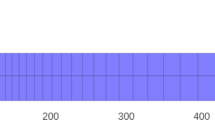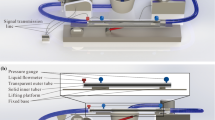Abstract
In this study, we applied a two-phase flow model to simulate water and sand blowout processes when penetrating shallow water flow (SWF) formations during deepwater drilling. We define ‘sand’ as a pseudo-component with high density and viscosity, which can begin to flow with water when a critical pressure difference is attained. We calculated the water and sand blowout rates and analyzed the influencing factors from them, including overpressure of the SWF formation, as well as its zone size, porosity and permeability, and drilling speed (penetration rate). The obtained data can be used for the quantitative assessment of the potential severity of SWF hazards. The results indicate that overpressure of the SWF formation and its zone size have significant effects on SWF blowout. A 10% increase in the SWF formation overpressure can result in a more than 90% increase in the cumulative water blowout and a 150% increase in the sand blowout when a typical SWF sediment is drilled. Along with the conventional methods of well flow and pressure control, chemical plugging, and the application of multi-layer casing, water and sand blowouts can be effectively reduced by increasing the penetration rate. As such, increasing the penetration rate can be a useful measure for controlling SWF hazards during deepwater drilling.
Similar content being viewed by others
References
Adams, N. J., and Kuhlman, L. G., 1991. Shallow gas blowout kill operations. The Proceedings of the Society of Petroleum Engineers Middle East Oil Show. Bahrain, 979–990.
Alberty, M. W., Hafle, M. E., Minge, J. C., and Byrd, T. M., 1999. Mechanisms of shallow water flows and drilling practices for intervention. SPE Drilling & Completion, 14 (2): 123–129.
Bogaerts, M., De Bruijin, G. G., Khalilova, P. R., Moretti, F., and Voon, E., 2012. Indentifying and mitigating the risks of shallow flow in deepwater cementing operations. The Proceedings of SPE Deepwater Drilling and Completions Conference. Galveston, Texas, 475–483.
Bruce, B., Bowers, G., and Borel, R., 2001. Well planning for shallow water flows and overpressures–The kestrel well. The Proceedings of Offshore Technology Conference. Houston, 669–671.
Bruce, R., McKeown, J., Sargent, T., and Garrett, R., 2003. Mitigating the shallow water flow risk at Mississippi Canyon 849: A team approach. The Proceedings of Offshore Technology Conference. Houston, USA, 1642–1648.
Cameron, C., 2005. Controlling shallow water flows in deep water. Offshore Mediterranean Conference and Exhibition. Ravenna, Italy.
Chen, T., and Guan, Z., 2000. Theory and Technology of Drilling Engineering. Petroleum University Press, Dongying, 215–217 (in Chinese).
Choe, J., and Juvkam-Wold, H. C., 1997. Unconventional method of conductor installation to solve shallow water flow problems. The Proceedings of SPE Annual Technical Conference and Exhibition. San Antonio, Texas, USA, 589–596.
Dong, C. Y., Zhang, Q. H., Cui, M. Y., Wang, P., Gao, Y. C., and Li, X. B., 2015. A dynamic sanding prediction model for unconsolidated sandstone reservoirs with complicated production conditions. Petroleum Drilling Techniques, 43 (6): 81–86 (in Chinese with English abstract).
Eaton, L. F., 1999. Drilling through deepwater shallow water flow zones at Ursa. The Proceedings of SPE/IADC Drilling Conference. Amsterdam, Holland, 153–164.
Eaton, L. F., Actis, S. C., Williamson, R. N., Vernier, C. G., and Long, J., 2005. Deepwater batchset operations through the Magnolia shallow water flow sand. The Proceedings of SPE/ IADC Drilling Conference. Amsterdam, Netherlands, 331–350.
Eoff, L., Sweatman, R., and Faul, R., 2000. New chemical systems and placement methods to stabilize and seal deepwater shallow-water flow zones. The Proceedings of Offshore Technology Conference. Houston, Texas, USA, 109–116.
Gao, Y. H., 2007. Study on multi-phase flow in wellbore and well control in deep water drilling. PhD thesis. China University of Petroleum, Qingdao.
Gao, Y. H., Sun, B. J., Zhao, X. X., and Wang, Z. Y., 2010. Dynamic simulation of kicks in deepwater drilling. Journal of China University of Petroleum (Edition of Natural Science), 34 (6): 66–91 (in Chinese with English abstract).
Huffman, A. R., and Castagna, J. P., 2000. Shallow water flow prediction from seismic analysis of multicomponent seismic data. The Proceedings of Offshore Technology Conference. Houston, Texas, USA, 99–107.
Mannaerts, H., Oldroyd, J., Williams, M., Fisher, R., Radjef, E., Day, R., Faulkerson, J., Pere, A., Sanders, R., Thomson, J., and Mix, K., 2005. Atlantis, the quest for its stray shallow water flow sands. Journal of Petroleum Technology, 57 (10): 50–52.
Maini, B. B., and Okazawa, T., 1987. Effects of temperature on heavy oil-water relative permeability of sand. Journal of Canadian Petroleum Technology, 26 (3): 33–41.
Medley, G. H. J., 1998. Shallow water flow technology update. The Proceedings of Offshore Technology Conference. Houston, Texas, USA, 183–187.
Ostermeier, R. M., Pelletier, J. H., Winker, C. D., Nicholson, J. W., Rambow, F. H., and Cowan, K. M., 2002. Dealing with shallow-water flow in the deepwater Gulf of Mexico. The Leading Edge, 21 (7): 660–668.
Pedersen, R. O., Taoutaou, S., Watts, B., Haugland, T., Stakkestad, A., and Oian, T., 2008. A successful field experience: Shallow water flow-how to avoid the need for an additional casing string. The Proceedings of IADC/SPE Drilling Conference. Orlando, Florida, USA, 1047–1057.
Pelletier, J. H., Ostermeier, R. M., Winker, C. D., Nicholson, J. W., and Rambow, F. H., 1999. Shallow water flow sands in the deepwater Gulf of Mexico: Some recent shell experience. International Forum on Shallow Water Flows Conference. League City, Texas, USA, 6–9.
Ren, S. R., Gong, Z. W., Zhang, L., Li, H. K., Han, B., Ren, J. H., and Zhang, Y., 2017. Shallow water flow hazard assessment in the northern slope of the South China Sea and control measures during deepwater drilling. Journal of China University of Petroleum (Edition of Natural Science), 41 (4): 99–106 (in Chinese with English abstract).
Roller, P. R., Magner, M. D., and Drury, R., 2001. Using conventional and unique methods to drill a technically demanding shallow flow zone. The Proceedings of SPE/IADC Drilling Conference. Amsterdam, Netherlands, 189–202.
Ruppelt, A. U., and West, C. L., 2004. Shallow water flow geopressure arising from confined subsurface slumps. The Proceedings of the Society of Petroleum Engineers Annual Technical Conference and Exhibition. Houston, Texas, USA, 4555–4562.
Schuberth, P. C., and Walker, M. W., 1999. Shallow water flow planning and operations: Titan #1 exploration well, deepwater Gulf of Mexico. The Proceedings of SPE/IADC Drilling Conference. Amsterdam, Netherlands, 165–177.
Whitfill, D. L., Heathman, J., Faul, R. R., and Vargo, R. F. J., 2000. Fluids for drilling and cementing shallow water flows. The Proceedings of SPE Annual Technical Conference and Exhibition. Dallas, Texas, USA, 127–137.
Acknowledgements
Financial supports by the 973 National Research Project of China (No. 2015CB251201), the program for Changjiang Scholars and Innovative Research Team in University (‘PCSIRT’) (IRT_14R58), and the Fundamental Research Funds for the Central Universities (No. 15CX0 5036A) are gratefully acknowledged.
Author information
Authors and Affiliations
Corresponding author
Rights and permissions
About this article
Cite this article
Ren, S., Liu, Y., Gong, Z. et al. Numerical simulation of water and sand blowouts when penetrating through shallow water flow formations in deep water drilling. J. Ocean Univ. China 17, 17–24 (2018). https://doi.org/10.1007/s11802-018-3454-5
Received:
Revised:
Accepted:
Published:
Issue Date:
DOI: https://doi.org/10.1007/s11802-018-3454-5




